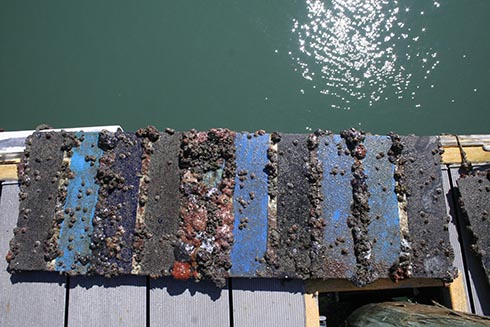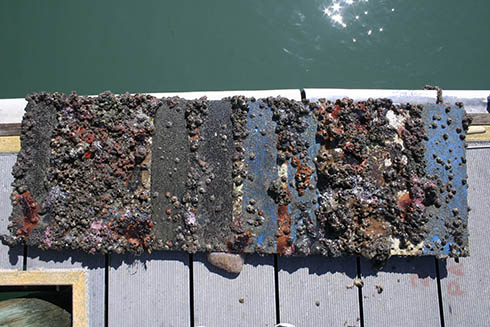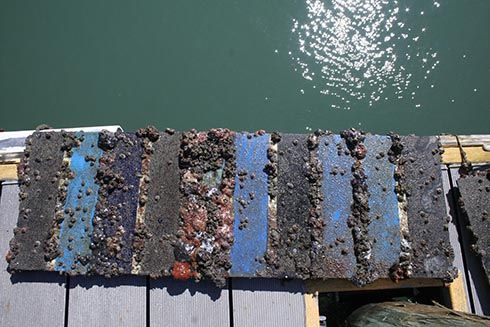
Our semi-annual inspection of bottom paint panels always yields a few surprises, but during the nearly ten years Ive been barnacle-counter-in-chief, I havent been more surprised than I was last month. The panels we inspected last month were painted and immersed in the summer of 2013. My inspection in January marked the eighteenth months of continuous immersion for approximately 60 paints that were undergoing testing. During a normal year, I would expect roughly 12-15 of those panels to still be fighting barnacles, but thats not what I found.
Every single panel was toast. The worst panels were unrecognizable, with a thick carpet of barnacles and soft growth covering the painted area (slightly less than one square foot). The best panels had thin coatings of slime, and about 10 percent of the panel was covered in barnacles and other hard growth. (Any hard growth qualifies as a failure in our test.)
Lets be clear. The conditions of our panel test are far more rigorous than the conditions your own boat will face, for several reasons:
- Our panels do not move, making it much easier for barnacles to become established.
- We keep our panels in warm, shallow, nutrient-rich Sarasota Bay, Florida. If barnacles were hosting a convention, theyd have it in Sarasota Bay.
- Except for a rinse every six months, we don’t clean our panels of slime or soft growth. Hard paints, in particular, can benefit from regular cleaning after the first year. (Start with a soft cloth and progress to a 3M scrub-pad as growth becomes more tenacious. Vigorous scrubbing will scrub away your protection. If you need a scraper, a haulout is long overdue.)
Although our test conditions are admittedly more strenuous than most boats will encounter, the fact remains: paints that during prior tests were barnacle-free at the 18-month interval had conspicuously failed this time around. Why?
Tweaks to the formulas could be a factor. A few of these paints have had their formulas changed slightly-either to meet new environmental restrictions on volatile organic compounds or to compensate for the rising cost of copper-but the majority were the same formulas we have been testing for years.
My guess is that conditions were simply more challenging than ever before, with warmer water temperatures and higher nutrient levels. Although we don’t track temperature, salinity, etc. from year to year, environmental factors have almost certainly played a role in past tests, though not to this degree.


The widespread failure among all paints was the headline event this year, but of almost equal importance were the results of new bottom paints containing Econea. Developed by a division of Janssen Pharmaceuticals, Econea is the latest chemical additive introduced as a substitute to copper biocide, which has come under scrutiny by the state and federal environmental agencies.
Along with a few copper-free single season paints for aluminum hulls, the Econea panels were the worst of the lot. This was not a huge surprise. With rare exception (Epaint in 2009), no copper-free paint has made it past the 18-month mark in our tests. The shocking part was the manner in which they failed-suddenly and completely. The potency of these paints doesn’t fade away; it stops, just like that. The best Econea paints that were still working great at 12 months (some didn’t make it that far), were completely carpeted at 18 months. The copper paints by comparison, saw more gradual declines in protection.
What does this mean for sailors? If you are inclined (or forced because of local legislation) to use an Econea-based antifouling paint, you can probably expect 12 months of protection-if you choose the right paint. But when that paint fails, it will likely fail all at once; there will be little, if any lingering protection to get you through the next six months or so, as is often the case with copper paints.
To be fair, I wouldnt say these results suggest that everyone should steer clear of Econea paints. Copper is clearly a safer bet, but as I pointed out, our panel tests are one bit of information to be used to guide your decision. Reducing the amount of biocide introduced to the ocean is a noble cause, and for a sailor who repaints every year after winter haulout, 12 months protection is just fine. And it could also be that an Econea-based paint will provide longer protection in your home waters, which are almost surely less fertile for barnacles. A more accurate assessment can only come through some real-world testing on actual boats in various regions.
The makers of Econea paints insist that they have seen very impressive results in the field, and the fact that more brands of Econea-based paints continue to appear on the market suggests that they do work better than our tests indicate. However, until we start applying these paints some of our test boat hulls (we will be doing this in the spring), and putting them to real world trials, well not be able to verify these claims. So far, we are unimpressed.
If you have been using an Econea-based paint, Id be very interested in hearing your experience. Please comment below or write to me at [email protected].
To find out which paints-copper and non-copper- fared best in our most recent antifouling tests, check out the April issue of Practical Sailor, which will be available online March 15. Or if you are buying right now, our recent results from March of 2014, which analyzes the best bottom paints by region, will serve as an excellent guide.





































